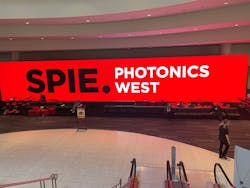It was a difficult decision to participate in SPIE Photonics West this year. Large companies such as Excelitas Technologies, Hamamatsu, and MKS Instruments pulled out, and many potential visitors stayed at home. Still, some people made it. The floor plan of the Photonics West exhibition named 779 exhibitors, roughly 60% of the 1300 exhibitors SPIE heralded at Photonics West 2020.
Those who couldn’t come were keen to know what this year’s trade show experience was like. Carlos Lee, director general of the European Photonics Industry Consortium (EPIC), said: “It’s slower, but people are really motivated and have time to talk. Those present really want to be here and have a motivation or reason to be present, resulting in high-quality discussions. And the general feeling of being happy to meet again.”
Agnes Huebscher, marketing director of Europe at Edmund Optics, told me: “It’s less traffic, but I have pre-arranged meetings, so I am fully busy. Visitors are more focused. So, there was more time to spend with booth visitors.”
Mark Tolbert, president of Toptica Photonics Inc., brought it to the point: “The numbers are higher than we expected.”
All small companies I talked to reported good visibility and great contacts. It seems as if the absence of larger companies has led to more attention for smaller companies.
The laser market is 22% up
Each year, Photonics West is the place for a first glimpse of the photonics markets. Several such reports are presented at the Lasers & Photonics Marketplace Seminar on Monday of the Photonics West week in San Francisco. Laser market analyst Arnold Mayer surprised with excellent numbers: “The market for industrial lasers and systems has grown 22% last year.” A main reason is (once again) an exceptional growth in China, which fits into the bigger picture. A week before, Reuters had reported record numbers in China’s trade balance. Their trade surplus grew another 29% from $524 billion in 2020 to $676 billion in 2021.
A big question is certainly related to supply chain issues. Tom Hausken from Optica commented on that in a recent article in Optics & Photonics News, “Just-in-time delivery is not as prevalent in optics and photonics as in some other sectors. But optics and photonics companies are reporting delayed shipments, longer lead times, and rising prices. Many suppliers are allocating shipments to preferred customers and asking for long-term purchasing agreements with heavy cancellation penalties.”Towards laser fusion
The scientific conference went on under full steam. The program was divided into four congresses with 92 conferences. There was no live transmission, but SPIE offers an interesting alternative: “From 21–27 February 2022, all attendees with a paid technical registration to Photonics West—either the event in San Francisco or the on-demand week—will be allowed to view the technical conference presentation recordings, posters and poster preview videos, and all recorded plenary and keynote presentations available for on-demand viewing.” Most notably, there is a charge for online participation.
There was a plethora of excellent scientific presentations. I would like to restrict myself to only one example. Tammy Ma from Lawrence Livermore National Laboratory reported on the breakthrough in laser fusion. Two scientific publications in Nature and Nature Physics published on January 26 now give the peer-reviewed details of last year’s astonishing experiments. In the coming months, a series of workshops at NIF will discuss further options in fusion research for the years to come.
What do we learn for the future?
According to Toptica’s Tolbert, “If the conference is hybrid, there are less walk-ins to the conference.” Sounds simple, but it is a crucial argument to reconsider plans for future online transmission of conferences. Furthermore, an online event creates costs. A free version can’t be profitable. The free online event popular over the last two years may be restricted as soon as travel is possible again.The LASER World of PHOTONICS trade fair in Munich won’t contribute to this discussion. The World of Photonics Congress follows its biannual schedule. It returns at the next regular LASER from June 25 to 29, 2023. It will be interesting to see which attrition results from the missing walk-ins from the congress in April 2022, when the trade show is the next big gathering of our community.
Another reason for attrition may come from the development of regional events. Events such as the trade shows in China (LASER World of PHOTONICS China had 1177 exhibitors in 2019) have grown in recent years. While people in Europe and America expect an end of COVID-19 restrictions soon, Asians may have a more conservative standpoint—and turn to their own event, which will further grow.
Cost consideration and growing sustainability demands will also contribute. Given such arguments for the growth of local events at least in Asia in this year, it will be interesting to see how this trend continues in the future. Will we see smaller international trade shows? At least, we can expect the return to exhibitor numbers of pre-pandemic times being severely slowed down.

Andreas Thoss | Contributing Editor, Germany
Andreas Thoss is the Managing Director of THOSS Media (Berlin) and has many years of experience in photonics-related research, publishing, marketing, and public relations. He worked with John Wiley & Sons until 2010, when he founded THOSS Media. In 2012, he founded the scientific journal Advanced Optical Technologies. His university research focused on ultrashort and ultra-intense laser pulses, and he holds several patents.

